#madmapper
Explore tagged Tumblr posts
Text
第50回定期演奏会の演出を担当しました
2025年3月30日(日) 、大阪府立春日丘高等学校吹奏楽部第50回定期演奏会でのプロジェクション・マッピング演出を担当しました。
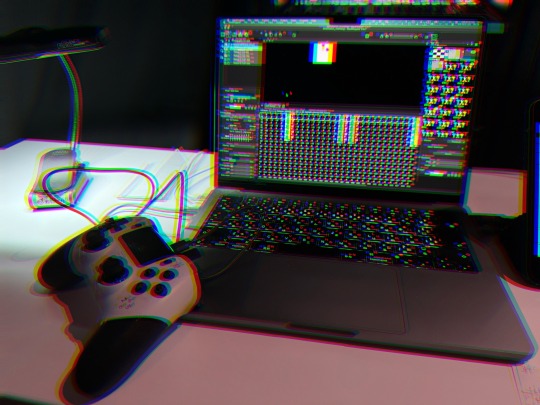
新しい取組み
MadMapperを用いたArt-Net経由でのムービングライト5台の同時制御(本番でも採用)
PS4互換コントローラーを用いたMadMapper制御(本番でも採用)
音声入り動画の自主制作と使用
使用したバージョン
MadMapper 5.6.7
0 notes
Text
ART Lounge 2025
Do, 27.03.2025, 18 – 23 Uhr – Wilhelm-Hack-Museum, Berliner Straße 23, 67059 Ludwigshafen Line Up: to66l & Seymen, Mapping: Gunnar Keppler Elektronische Musik, dazu Video-Mapping + Art Talks, Ausstellung und feine Drinks.Kurz: Tanz- und erlebbare Kunst vom feinsten. Hier ein paar Impressionen von 2023:
#ART-Talk#ARTLounge#Audiovisuelle Performance#Ausstellung#DJs#Drinks#Gunnar Keppler#Jo Jacobs#Live-Musik#Madmapper#Party#Projectionmapping#Seymen#to66l#Visuals#WALDRAUSCHEN#wilhelmhackmuseum
0 notes
Text
#videomapping#live performance#avperformance#light installation#laser mapping#stage design#vjing#madmapper
0 notes
Text
「Expended Field」 WIP
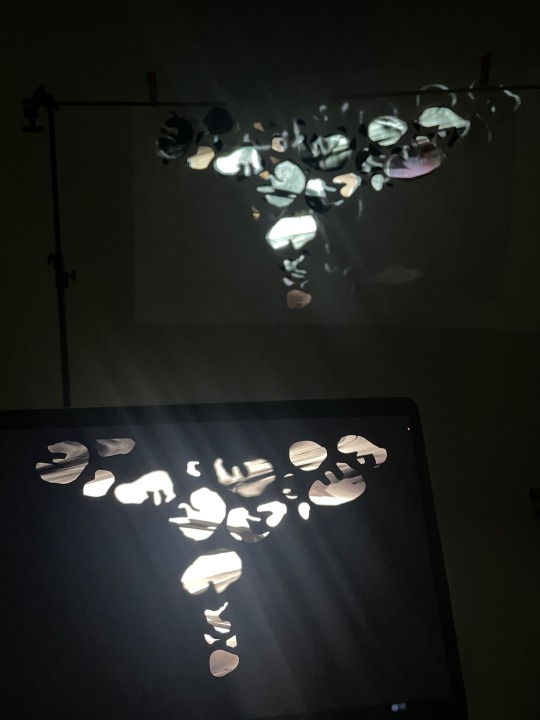
Roughly masking in real time:
1 note
·
View note
Photo
Lol
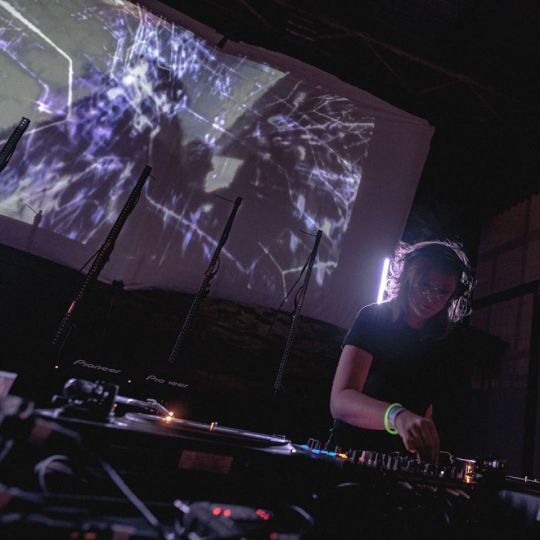
Performance Live Art VJ et LED
🌻 Mercredi 14 août 2019 quelque part entre Metz et Saint-Avold 🌻
Informations sur la soirée : https://www.facebook.com/events/393988247906298/
+ > https://vimeo.com/vjno/
2 notes
·
View notes
Text
Forefront Research-Artist
This artist utilizes an Optoma projector and MadMapper (a projection mapping software) to create a new form of art. She first places a physical painting leaning against the wall, then projects an animation onto it, making the artwork appear as if it’s moving.
I really like the idea of merging both digital and physical art. I'm planning to use real dining equipment, such as bowls and chopsticks, and explore how I can make the digital elements interact with the physical ones.
instagram
instagram
Projection on huge sculpture Height: 45 feet Materials: Glass Fibre Re-enforced Concrete, Steel, Plants The projected light and shadow on the statue transform its face into various appearances, with different colors and lines, giving it a more sci-fi and surreal feeling. I also hope my work can bring a similar transformation to the stone table in the restaurant, making it feel completely different. This piece is bold and playful, it really grabs attention and invites people to stop and take a closer look. I hope my projection project can also have the same effect.
instagram
instagram
The two pieces above are similar to the first one mentioned in this article, all of them involve projecting digital animation onto physical paintings.
What makes the final piece stand out is its use of three projection walls, which creates a much more immersive spatial atmosphere.
If possible, it would be amazing to transform the restaurant where I'm planning to create my projection project into a magical castle, that would be so cool! References:
Dilworth, L., 2024. [TikTok video]. [video] TikTok. Available at: https://www.tiktok.com/@dil.worth/video/7453163492577774894 [Accessed 9 July 2025].
DELIVERED., 2024. [Instagram post]. [image] Instagram, 8 January. Available at: https://www.instagram.com/p/DEjweaOTJys/?utm_source=ig_embed [Accessed 9 July 2025].
Dilworth, L., 2024. [Instagram video]. [video] Instagram, 16 February. Available at: https://www.instagram.com/p/DGJB2WzI59G/?utm_source=ig_embed&utm_campaign=embed_video_watch_again [Accessed 9 July 2025].
0 notes
Text
VJ software
FREE
Krita for concept creation
Inkscape for vector design
OpenToonz and Pencil2D Animation
Blender for 3D animation
Natron for compositing
OBS Studio for live streaming
ShareX for screencasting
OpenShot Video Editor for streamlined video editing.
VPT – Toolkit free projection mapping tool. Have to learn it, for creating shows, comes with all the essentials you need, like OSC, midi, audio analysis. Built using C++ if you are a creative coder this can be your tool of choice to create mind-blowing shows.
Synthesia Live – Live Visuals - good for audio-reactive generative visuals. Free
NOT FREE
Resolume - widely used easy for beginners - Resolme Arena for video mapping, LED installs - good starting place
Modul8 - for Mac - easy connects with MadMapper for video projection - can control lights etc
MixEmergency - connects to Serato series of software. Easy, can send and receive high definition video streams, can mix video between computers, easily change between Video DJs, mix with 3 or more decks
VUO – Interactive Media for creating new media installations. VUO is similar to creative coding tools like Processing, OpenFrameworks, TouchDesigner, etc. It comes with easy to use modules that can get you started with a variety of interactive video projects without any coding.
Painting with Light – Video Art for generating content on the fly. video mapping tool for static and moving images through any video projector onto 3D physical objects.
NotchVFX – Real Time Graphics a real-time production software. Works with a media server - make motion graphics, real-time tracking, virtual worlds and a whole lot more. Real time/live.
VDMX live video input, quartz compositions, custom layout, audio analysis for live visuals, audio-reactive content, music events
Arkaos full-blown VJ software inc projection mapping, musicians like it, inks directly with Pioneer Pro DJ network.
CoGe VJ – VJ Tool limit is the computing power of your machine/graphics card. connects with software like Quartz, IFS generator, VUO image generators, Syphon sources for live camera and other inputs.
VVVV – Interactive Media - toolkit, a node based software that opens up the creative abilities of your hardware. Allowing you to create just about anything you can visualize. Live data input, motions tracking, OpenCV, multi-screen projection. Create live media environments.
Sparck – Immersive Content - immersive interactive spatial augmented reality installation, can project real-time generated virtual content. It helps you to turn your world into a 360° VR environment no matter the shape of your surfaces.
Smode Studio – Interactive Media Server VJ software along with a media server. Control visuals using Audio, Midi, OSC and display directly or use the power of Smode with spout to run visuals into your VJ software
MPM - open source framework for 3D projection mapping using multiple projectors. It contains a basic rendering infrastructure and interactive tools for projector calibration.
Visution – Projection Mapping versatile video projection mapping software. Allows interaction by pixel rather than other tools which restrict you with grid points. The good part is Mapio2 allows you to throw virtually any video format into your media playlist. For multi-screen setups, projection mapping and permanent installs with a show mode and autostart.
Vioso – Projection Mapping - to align multi projection set ups
Scalable Display – Auto Projection Alignment & Blending uses a camera to automatically wrap and align projectors up to 16 from a single PC. For a permanent installation, this can be very useful, reducing on-site visits and provide robust software to align and wrap your image.
Edge – Media Server - for video mapping. Use this for permanent installations for advertising, museums, retail and other places where you need a robust solution. Edge C is a video server, Edge DS is for digital signage
Mapstard – Media Server This is a timeline controlled video server, not really for live VJing. For controlled shows, where you have pre-defined content to play. DMX functionalities allow timeline control.
Dataton Watchout – Media Server Works on a network of computers connecting your main machine to control slave machines. Allowing you to connect as many projectors as your hardware can handle. Easily create timeline shows, similar to using video editing tools. This is a great option for corporate shows where you need to run content on cue. Watchout display output only works if you buy their dongle.
Millumin – can be used as a media server, can load 3D models for mapping, control light fixtures, connect with external controllers, timeline your show and much more.
Ai Server – Media Server Integrates with leading hardware and software that run behind the console for large scale setups, permanent installs. Integrates with NotchVFX for your real-time shows.
Disguise – Media Server
D3 media server for light shows, do the whole show with this.
Hippotizer – Media Server
Hippotizer - media server for pixel mapping to projection mapping, small scale to large scale
Comes from https://limeartgroup.com/the-mega-list-of-vj-software-and-tools/
Malika Maria
Starting creative coding - what kit do I need?
0 notes
Photo

Welcome to Refinery29’s Why I Code, a Changing Face series where we ask inspirational, tech-disrupting trailblazers in computer science 29 questions about what fuels them on and off the clock. New York-based artist and designer Anya Karolyn never thought her longtime hobby of creating different types of art could turn into a full-time career. One dream art studio in Manhattan and successful print and apparel business later, it’s safe to say that she’s singing a different tune. As a mixed-media artist, Karolyn weaves together her passion for creating on a physical canvas with Photoshop-level computer editing and coding. You might call her a modern renaissance woman, constantly innovating via graphics and code. Growing up, Karolyn considered herself an “art kid,” but always thought it would just be something she enjoyed quietly. “[Art] was the thing that first gave me confidence in my identity because I wasn’t really identifying with anything else in school,” says the 26-year-old Boulder, CO native. “In art class, I just felt this weird sense of confidence that I didn’t have in any other aspect of my life, but I never thought it could be a full-time career — I didn’t even go to college for art. It was very much a fun talent I had.” Now, she’s fully immersed in KARO, her very own ever-evolving art project and business — but her journey to get there wasn’t always a straight line. “It’s [been] years and years of tiny baby steps, nuanced realizations, and breaking out of self-limiting beliefs,” she shares. “There have been so many sleepless nights, all-nighters on projects that I never got paid for, projects that never saw the light of day, or things that I felt were just a waste.” She started growing KARO on the side in 2018, but at the time, she was working as an in-house creative in the music industry at a major label, doing anything from directing music videos to animating lyric videos and GIFs to shooting single covers to editing concert recaps. “I was constantly working to make other artists’ visions come to life, and I kept asking myself, Why can’t I bet on myself like that? Am I going to live my whole life feeling like I’m in the wrong role? I was working at this job close to 50 hours per week, and then staying up every night working on art for KARO,” she says. “I couldn’t take it anymore eventually and saved up enough to give myself a chance and quit. The momentum built really quickly and it hasn’t stopped, which I’m super thankful for.” As Karolyn prepares for her first solo show in NYC, she’s incorporating coding into the experience in a unique and interactive way — another example of her layered approach to art. Although she doesn’t code in her daily life, she finds innovative ways to shape code to create anything her heart desires. DashDividers_1_500x100 What’s the first thing you’ve ever coded? “The first thing I ever coded was a ‘choose your own adventure’ game in Python, which I think, is a pretty simple first project. It allowed a player to navigate different story paths, and it was really cute. It was my first experience structuring logic [in coding].” What’s a project that was the most challenging for you? “The one that I’m doing right now in terms of coding integration because I’m learning how to do projection mapping for my next art show. I have so many ideas for it and I want it to be really special and custom. Projection mapping is so cool in the art world because you can enhance a piece of art by creating animations around it to supplement it. “I’m first using [TouchDesigner] to create animations of motifs, poetry, and visuals of my work, then using [MadMapper] to do custom projection mapping onto the gallery space. I have some time — which is good — but it’s a multi-step process that I haven’t done before. It’s a great way to merge nontraditional coding and technology with art, and I love being very much in the weeds with everything that I do for KARO.” What’s the first thing you do when you wake up? “I have to start my espresso machine. I also like to physically rise as soon as my alarm goes off. Because, once I’m up, I’m up. I used to have the bad habit of snoozing my alarm all the time. So now, I need to physically shake myself around, defrost my brain in the morning, turn on my espresso machine, and make myself a little latte.” What’s the last thing you do before going to bed? “I have my little nighttime routine and the biggest anchor of that is journaling. I love journaling. I really believe in it — I think it’s so powerful. I’ve been journaling nearly every day for years and years. I’ll go periods without it, but even since high school, I’ve been keeping a journal ,and it just helps decompress my brain and get me calm for the night.” When does inspiration strike for you? “100% at night — never once in the morning. I’m such a night owl. My brain takes a couple hours in the morning to defrost. I’ve always wanted to be a morning person that wakes up really early and is super productive, but I just had to accept that I’m more productive, creative, inspired, motivated, and energetic at night, and I can’t change it. That’s why I started talking about this on my YouTube channel. I made a video about it. I have a day shift and I have a night shift. My night shift is where the actual magic happens.” What does your workspace look like? “My studio is honestly a perfect reflection of myself. It’s my inner self materialized as a physical space. It’s kind of artistically messy. It’s very playful and it’s fun. There are lots of colors, but there’s a lot of intention behind the little knick-knacks everywhere. It’s like a showroom of my brain.” What do you do when you’re stuck in a rut? “I’ll journal or I’ll go for a walk. Going for a walk always resets my mental health — I love walking around in New York. Dancing in my studio [also helps]. I’ll put on a song that I love dancing to — it’s one of my greatest joys. That will really get me out of a rut [because it helps] to physically move myself. Also, sleeping. If I’m stuck in a rut, it’s likely because I’m getting burnt out. I tend to work myself to burn out pretty easily. Then, I’ll cancel plans and I’ll sleep because sometimes I just really need a mental reset. I need to sleep in without an alarm and I’ll feel so much better the next day.” What’s one thing you wish to accomplish? “A solo show in New York City! That one’s easy for me, because I’m already planning it right now, but it’s something I’ve always wanted to do. What’s your favorite piece of advice that you’ve gotten? “Leap and the net will appear. I just got LEAP tattooed on my hand [laughs].” Who inspires you the most? “A mix of all of my New York City artist friends that I spend my time with. There’s this very beautiful, artistic, creative community that I feel so giddy to be a part of. I see their journeys and I see what they’re up to and how they keep going. As an artist in my 20s in New York, I just love being a part of that; they inspire me so much. I feel like I’m kind of a mosaic of these people that are around me.” Who, if anyone, do you try to emulate? “I almost want to be a person that’s emulated — which I have seen when I start getting tagged in things and people would say, “This is so KARO.” It’s honestly the biggest form of flattery.” What’s something people ask you for advice about often? “People always ask me how to quit their job that they’re not happy with when they have artistic passions. I hear that all the time and that’s my favorite conversation to have. You can put me in a room with someone for an hour who’s on the brink of quitting their job and I’ll make them quit [laughs].” What’s a piece of advice you felt proud to give? “Definitely the above advice. It’s wild because a couple of years ago, I was on the other side of it, and wondering, How do I quit my job? It’s the most terrifying thing in the world. I had to ask myself: Are my passions legitimate? Or are they just this silly hobby? I had so many self-limiting beliefs and so many things that I was worried about. [It’s great] to be in a position where, I know for a fact, that I made the right decision. There’s no doubt or anxiety in my head, and I feel very thankful.” What is your most-used app on your phone? “It was StreetEasy until I finally found my dream apartment recently. I was using StreetEasy like it was Instagram — I was refreshing it every day. But now, it’s probably CapCut because I edit nearly everything on it. I spend so much time on there — my screen time goes way up because of how much time I’m working on it.” What do you do when you feel yourself burning out? “I will cancel all of my plans to give myself time to be alone, journal, exercise, and sleep. I need my alone time. I’m a very social introvert, but I need to recharge by myself.” What’s something you consider a secret weapon? “I think I have a couple. First, it’s the fact that both of my parents are immigrants. I grew up multiculturally and my stepfamily is also from a completely different culture than my own. My mom is from Peru, my dad is from Germany, and my stepfamily is Lebanese. I was raised trilingual with Spanish and German. My German isn’t that great, though. Growing up with an immigrant family really influenced my worldview, work ethic, and appreciation of diverse experiences. It feels like a superpower. Ever since I was a kid, I’ve had a much more open mind and a much bigger world view. I think that’s a huge privilege: to be able to see a bigger map of the way people live. My other secret weapon is that I know how to do all the parts of KARO that I’m doing — the business stuff, the software, the Photoshop editing, and the animations. I don’t have to rely on other people all of the time and I can be independent in a lot of respects. People can be intimidated and think they need to hire people for everything — which isn’t always true especially when you’re just starting out.” Where are you, compared to where you thought you’d be at 12 years old? “I’m light years beyond where I thought I’d be when I was 12 years old! My 12-year-old self could not even fathom where I could possibly be today. I just did not have any self-confidence at 12 years old, and I totally didn’t think that what I’m doing was even an option. I just kind of saw my life going in a very traditional, nuclear [direction] like everyone around me.” What’s been your biggest piece of support, helping you get to where you are? “My friends and loved ones in my life just loving me and always being supportive of my ideas and not making me feel weird about them. I know a lot of people that try and put themselves out there, and their friends are just like, ‘Why are you doing that?’ The judgment can be a major block. My friends would always like my posts on Instagram when I had zero followers and they would share them. Also, the people who follow me and have been supporting and talking about my art in person to other people. And anyone wearing my work or putting it in their home. That is what makes it possible for me to have this as a full-time career — that kind of support. I’m extremely grateful that I have an audience now. I would be doing this regardless, and I have been doing this my whole life, but the only difference now and why I can make it a career is because I have an audience that listens now.” If you could change one thing about your professional life, what would it be? “I wish I had more free time. It’s astounding how quickly a day goes by because my to-do list is never-ending, and it’s mostly filled with things that I’m really excited about and want to do. I love what I do. It’s just that there’s no time.” What do you do to start your workday? “Timeboxing. I block out my day because I’m very scatter-brained and all over the place. I have a never-ending to-do list, and it forces myself to pick three top priorities for the day, and then I can brain-dump in another section [of my planner], and then I can time-lock another section. It helps my brain immensely. I cannot go through a day without a time box or else the day is going to be a mess and I’m going to feel terrible.” What do you do to end your workday? “I’ll journal again. I like to exercise and take weird workout classes. By weird, I mean, I’ll just try new things. There’s a studio right next to my studio that does really fun pole classes, hoop classes, trapeze, and aerial art. It’s really cool.” Why do you code? “[I code] when there’s a specific effect I want to achieve with my art like projection-mapping. It gets me where I want to go and is the tool to get me there.” What’s one thing you’d change about your industry? “[I wish there was] more support and representation for women — women in higher positions and more female voices. I love the initiative that certain companies are taking now. Computer Science is Everything especially, with its efforts to empower women. I love that initiative, and that’s so much of what I want to have for my own brand, too. I’ve seen so much misogyny in the industries that I’ve worked in. So, continuing to put myself out there is hopefully a little tiny piece of that change. We need more female voices in these industries.” What are you hoping the future of tech will look like? “Definitely to see more representation and more female-led businesses.” Like what you see? How about some more R29 goodness, right here? Source link
0 notes
Photo

Welcome to Refinery29’s Why I Code, a Changing Face series where we ask inspirational, tech-disrupting trailblazers in computer science 29 questions about what fuels them on and off the clock. New York-based artist and designer Anya Karolyn never thought her longtime hobby of creating different types of art could turn into a full-time career. One dream art studio in Manhattan and successful print and apparel business later, it’s safe to say that she’s singing a different tune. As a mixed-media artist, Karolyn weaves together her passion for creating on a physical canvas with Photoshop-level computer editing and coding. You might call her a modern renaissance woman, constantly innovating via graphics and code. Growing up, Karolyn considered herself an “art kid,” but always thought it would just be something she enjoyed quietly. “[Art] was the thing that first gave me confidence in my identity because I wasn’t really identifying with anything else in school,” says the 26-year-old Boulder, CO native. “In art class, I just felt this weird sense of confidence that I didn’t have in any other aspect of my life, but I never thought it could be a full-time career — I didn’t even go to college for art. It was very much a fun talent I had.” Now, she’s fully immersed in KARO, her very own ever-evolving art project and business — but her journey to get there wasn’t always a straight line. “It’s [been] years and years of tiny baby steps, nuanced realizations, and breaking out of self-limiting beliefs,” she shares. “There have been so many sleepless nights, all-nighters on projects that I never got paid for, projects that never saw the light of day, or things that I felt were just a waste.” She started growing KARO on the side in 2018, but at the time, she was working as an in-house creative in the music industry at a major label, doing anything from directing music videos to animating lyric videos and GIFs to shooting single covers to editing concert recaps. “I was constantly working to make other artists’ visions come to life, and I kept asking myself, Why can’t I bet on myself like that? Am I going to live my whole life feeling like I’m in the wrong role? I was working at this job close to 50 hours per week, and then staying up every night working on art for KARO,” she says. “I couldn’t take it anymore eventually and saved up enough to give myself a chance and quit. The momentum built really quickly and it hasn’t stopped, which I’m super thankful for.” As Karolyn prepares for her first solo show in NYC, she’s incorporating coding into the experience in a unique and interactive way — another example of her layered approach to art. Although she doesn’t code in her daily life, she finds innovative ways to shape code to create anything her heart desires. DashDividers_1_500x100 What’s the first thing you’ve ever coded? “The first thing I ever coded was a ‘choose your own adventure’ game in Python, which I think, is a pretty simple first project. It allowed a player to navigate different story paths, and it was really cute. It was my first experience structuring logic [in coding].” What’s a project that was the most challenging for you? “The one that I’m doing right now in terms of coding integration because I’m learning how to do projection mapping for my next art show. I have so many ideas for it and I want it to be really special and custom. Projection mapping is so cool in the art world because you can enhance a piece of art by creating animations around it to supplement it. “I’m first using [TouchDesigner] to create animations of motifs, poetry, and visuals of my work, then using [MadMapper] to do custom projection mapping onto the gallery space. I have some time — which is good — but it’s a multi-step process that I haven’t done before. It’s a great way to merge nontraditional coding and technology with art, and I love being very much in the weeds with everything that I do for KARO.” What’s the first thing you do when you wake up? “I have to start my espresso machine. I also like to physically rise as soon as my alarm goes off. Because, once I’m up, I’m up. I used to have the bad habit of snoozing my alarm all the time. So now, I need to physically shake myself around, defrost my brain in the morning, turn on my espresso machine, and make myself a little latte.” What’s the last thing you do before going to bed? “I have my little nighttime routine and the biggest anchor of that is journaling. I love journaling. I really believe in it — I think it’s so powerful. I’ve been journaling nearly every day for years and years. I’ll go periods without it, but even since high school, I’ve been keeping a journal ,and it just helps decompress my brain and get me calm for the night.” When does inspiration strike for you? “100% at night — never once in the morning. I’m such a night owl. My brain takes a couple hours in the morning to defrost. I’ve always wanted to be a morning person that wakes up really early and is super productive, but I just had to accept that I’m more productive, creative, inspired, motivated, and energetic at night, and I can’t change it. That’s why I started talking about this on my YouTube channel. I made a video about it. I have a day shift and I have a night shift. My night shift is where the actual magic happens.” What does your workspace look like? “My studio is honestly a perfect reflection of myself. It’s my inner self materialized as a physical space. It’s kind of artistically messy. It’s very playful and it’s fun. There are lots of colors, but there’s a lot of intention behind the little knick-knacks everywhere. It’s like a showroom of my brain.” What do you do when you’re stuck in a rut? “I’ll journal or I’ll go for a walk. Going for a walk always resets my mental health — I love walking around in New York. Dancing in my studio [also helps]. I’ll put on a song that I love dancing to — it’s one of my greatest joys. That will really get me out of a rut [because it helps] to physically move myself. Also, sleeping. If I’m stuck in a rut, it’s likely because I’m getting burnt out. I tend to work myself to burn out pretty easily. Then, I’ll cancel plans and I’ll sleep because sometimes I just really need a mental reset. I need to sleep in without an alarm and I’ll feel so much better the next day.” What’s one thing you wish to accomplish? “A solo show in New York City! That one’s easy for me, because I’m already planning it right now, but it’s something I’ve always wanted to do. What’s your favorite piece of advice that you’ve gotten? “Leap and the net will appear. I just got LEAP tattooed on my hand [laughs].” Who inspires you the most? “A mix of all of my New York City artist friends that I spend my time with. There’s this very beautiful, artistic, creative community that I feel so giddy to be a part of. I see their journeys and I see what they’re up to and how they keep going. As an artist in my 20s in New York, I just love being a part of that; they inspire me so much. I feel like I’m kind of a mosaic of these people that are around me.” Who, if anyone, do you try to emulate? “I almost want to be a person that’s emulated — which I have seen when I start getting tagged in things and people would say, “This is so KARO.” It’s honestly the biggest form of flattery.” What’s something people ask you for advice about often? “People always ask me how to quit their job that they’re not happy with when they have artistic passions. I hear that all the time and that’s my favorite conversation to have. You can put me in a room with someone for an hour who’s on the brink of quitting their job and I’ll make them quit [laughs].” What’s a piece of advice you felt proud to give? “Definitely the above advice. It’s wild because a couple of years ago, I was on the other side of it, and wondering, How do I quit my job? It’s the most terrifying thing in the world. I had to ask myself: Are my passions legitimate? Or are they just this silly hobby? I had so many self-limiting beliefs and so many things that I was worried about. [It’s great] to be in a position where, I know for a fact, that I made the right decision. There’s no doubt or anxiety in my head, and I feel very thankful.” What is your most-used app on your phone? “It was StreetEasy until I finally found my dream apartment recently. I was using StreetEasy like it was Instagram — I was refreshing it every day. But now, it’s probably CapCut because I edit nearly everything on it. I spend so much time on there — my screen time goes way up because of how much time I’m working on it.” What do you do when you feel yourself burning out? “I will cancel all of my plans to give myself time to be alone, journal, exercise, and sleep. I need my alone time. I’m a very social introvert, but I need to recharge by myself.” What’s something you consider a secret weapon? “I think I have a couple. First, it’s the fact that both of my parents are immigrants. I grew up multiculturally and my stepfamily is also from a completely different culture than my own. My mom is from Peru, my dad is from Germany, and my stepfamily is Lebanese. I was raised trilingual with Spanish and German. My German isn’t that great, though. Growing up with an immigrant family really influenced my worldview, work ethic, and appreciation of diverse experiences. It feels like a superpower. Ever since I was a kid, I’ve had a much more open mind and a much bigger world view. I think that’s a huge privilege: to be able to see a bigger map of the way people live. My other secret weapon is that I know how to do all the parts of KARO that I’m doing — the business stuff, the software, the Photoshop editing, and the animations. I don’t have to rely on other people all of the time and I can be independent in a lot of respects. People can be intimidated and think they need to hire people for everything — which isn’t always true especially when you’re just starting out.” Where are you, compared to where you thought you’d be at 12 years old? “I’m light years beyond where I thought I’d be when I was 12 years old! My 12-year-old self could not even fathom where I could possibly be today. I just did not have any self-confidence at 12 years old, and I totally didn’t think that what I’m doing was even an option. I just kind of saw my life going in a very traditional, nuclear [direction] like everyone around me.” What’s been your biggest piece of support, helping you get to where you are? “My friends and loved ones in my life just loving me and always being supportive of my ideas and not making me feel weird about them. I know a lot of people that try and put themselves out there, and their friends are just like, ‘Why are you doing that?’ The judgment can be a major block. My friends would always like my posts on Instagram when I had zero followers and they would share them. Also, the people who follow me and have been supporting and talking about my art in person to other people. And anyone wearing my work or putting it in their home. That is what makes it possible for me to have this as a full-time career — that kind of support. I’m extremely grateful that I have an audience now. I would be doing this regardless, and I have been doing this my whole life, but the only difference now and why I can make it a career is because I have an audience that listens now.” If you could change one thing about your professional life, what would it be? “I wish I had more free time. It’s astounding how quickly a day goes by because my to-do list is never-ending, and it’s mostly filled with things that I’m really excited about and want to do. I love what I do. It’s just that there’s no time.” What do you do to start your workday? “Timeboxing. I block out my day because I’m very scatter-brained and all over the place. I have a never-ending to-do list, and it forces myself to pick three top priorities for the day, and then I can brain-dump in another section [of my planner], and then I can time-lock another section. It helps my brain immensely. I cannot go through a day without a time box or else the day is going to be a mess and I’m going to feel terrible.” What do you do to end your workday? “I’ll journal again. I like to exercise and take weird workout classes. By weird, I mean, I’ll just try new things. There’s a studio right next to my studio that does really fun pole classes, hoop classes, trapeze, and aerial art. It’s really cool.” Why do you code? “[I code] when there’s a specific effect I want to achieve with my art like projection-mapping. It gets me where I want to go and is the tool to get me there.” What’s one thing you’d change about your industry? “[I wish there was] more support and representation for women — women in higher positions and more female voices. I love the initiative that certain companies are taking now. Computer Science is Everything especially, with its efforts to empower women. I love that initiative, and that’s so much of what I want to have for my own brand, too. I’ve seen so much misogyny in the industries that I’ve worked in. So, continuing to put myself out there is hopefully a little tiny piece of that change. We need more female voices in these industries.” What are you hoping the future of tech will look like? “Definitely to see more representation and more female-led businesses.” Like what you see? How about some more R29 goodness, right here? Source link
0 notes
Text
第15回パラダイスコンサートの演出を担当しました
2024年12月22日(日) 、第15回パラダイスコンサートでのプロジェクション・マッピング演出を担当しました。
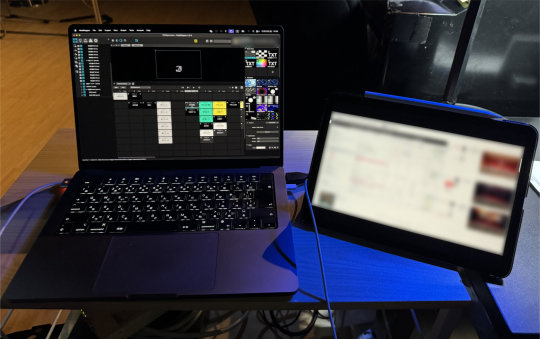
新しい取り組み
特になし(MadMapper 5系を使用するのはおそらく最後になるのでこれまでの総復習のつもりで基本に立ち返ってシンプルに実装しました)
使用したバージョン
MadMapper 5.6.6
0 notes
Text
ART Lounge 2023
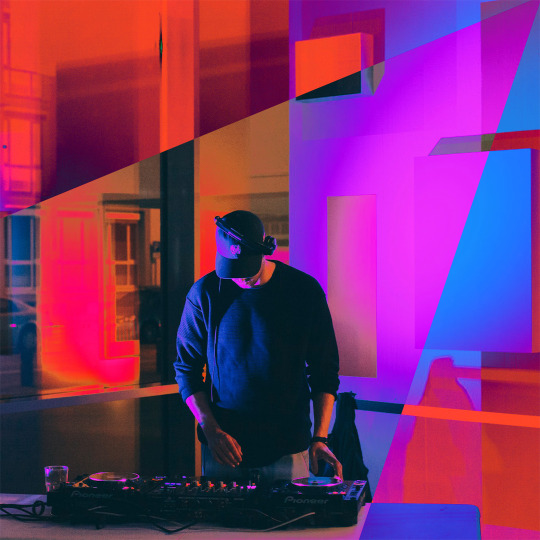
View On WordPress
#!YO-Live#ART-Talk#ARTLounge#Ausstellung#DJs#Drinks#Jo Jacobs#Live-Musik#Madmapper#Mondrian#Party#Projectionmapping#to66l#Visuals#WALDRAUSCHEN#wilhelmhackmuseum
0 notes
Text
「Expended Field」 WIP
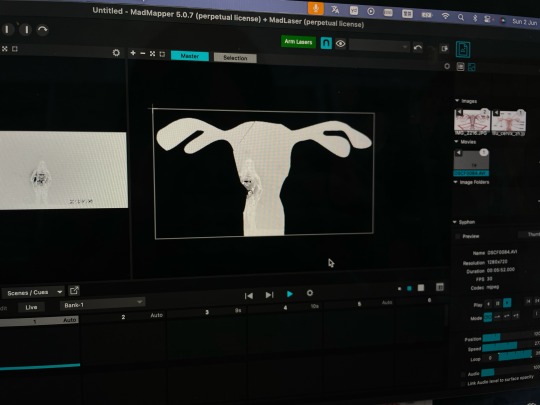
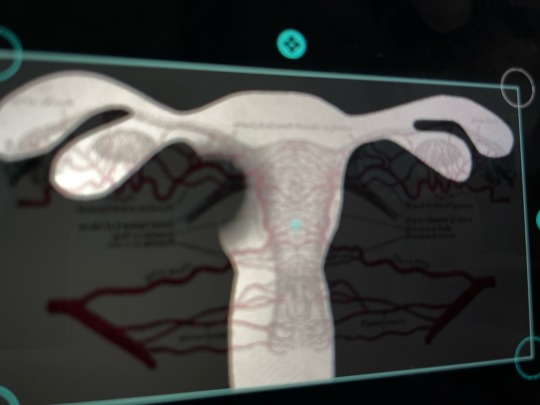

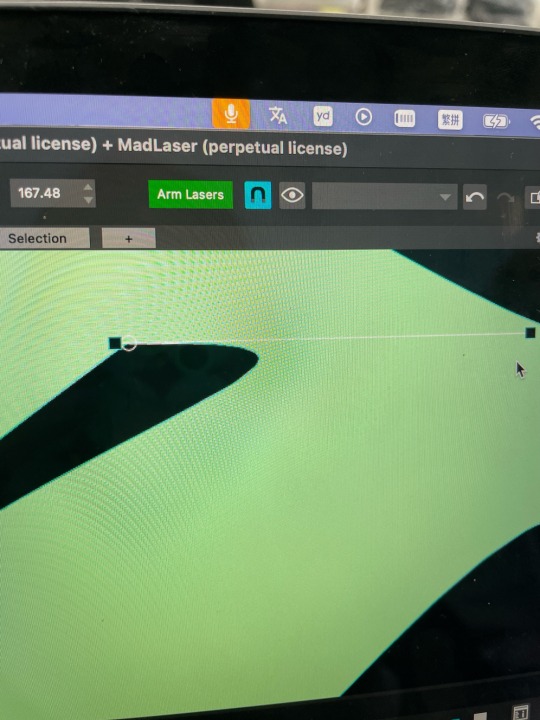

Half for an example, later need to finalize the sharp part…
It tooks me extremely long time to draw the masks.
Procedure - From left one to right bottom -> How I made those masking
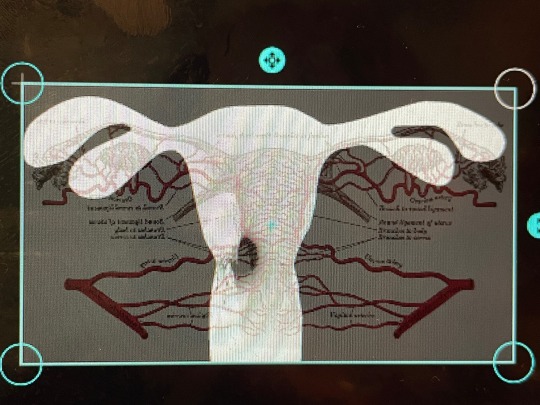

Checking position with my installation
0 notes
Text
Art Studio 2 Projection/installation test 1 (16.9.24)
This installation test was conducted as per Harry's recommendation (https://www.tumblr.com/aangussca/760848468720893952/art-studio-2-installation-sculptures-concept?source=share).
The program MadMapper and a vertical projector were used for this test (note that, due to not being very familiar with MadMapper's interface and doing the projection outlines free-handed (no reference), the 'mapping silhouettes' for both sculptures are not exact).
Aquatic sculpture prototype with projected short film segment and 'mapping silhouette'
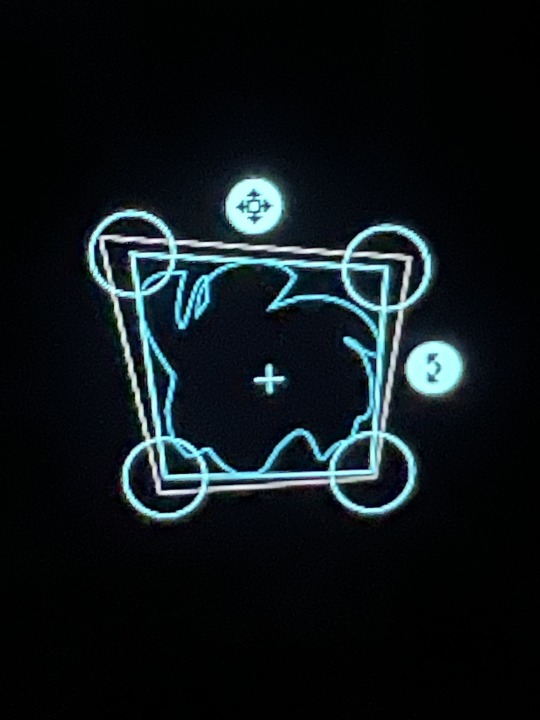
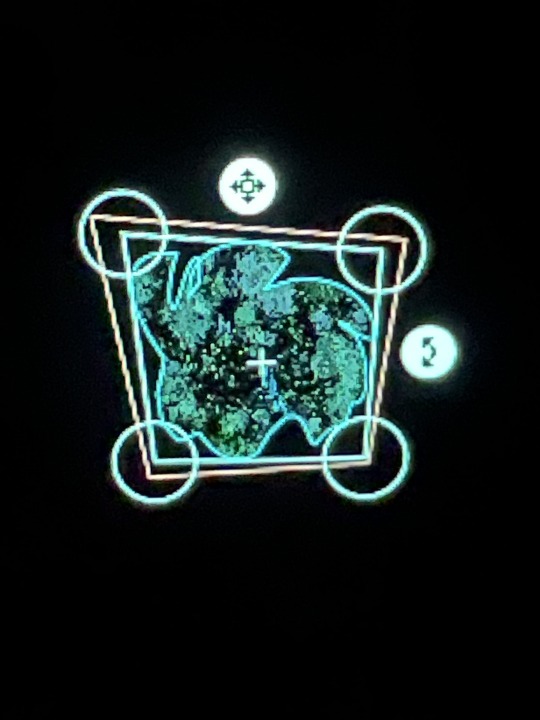
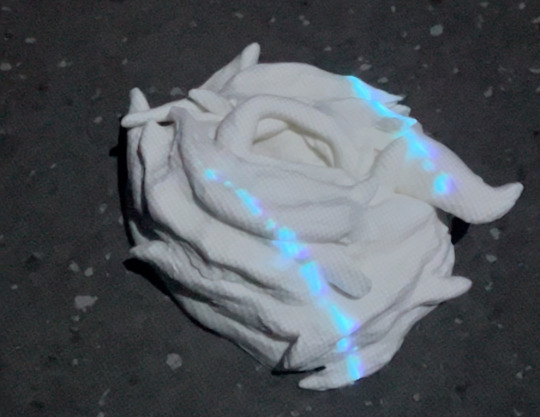
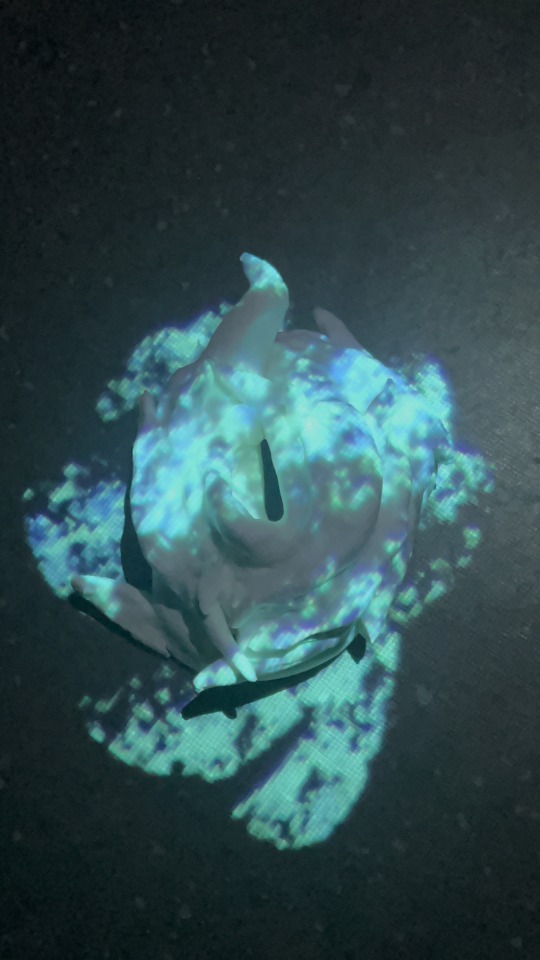
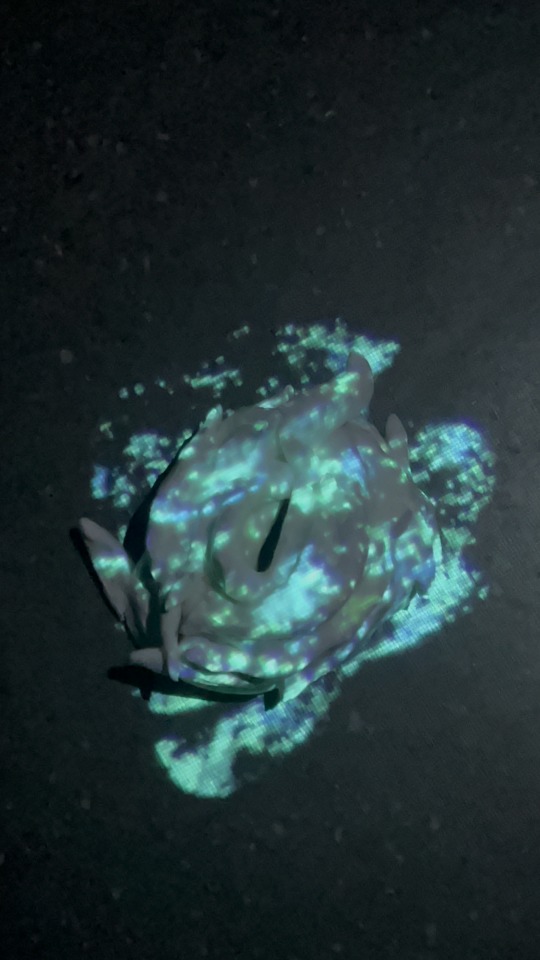
Terrestrial sculpture prototype with projected short film segment and 'mapping silhouette'
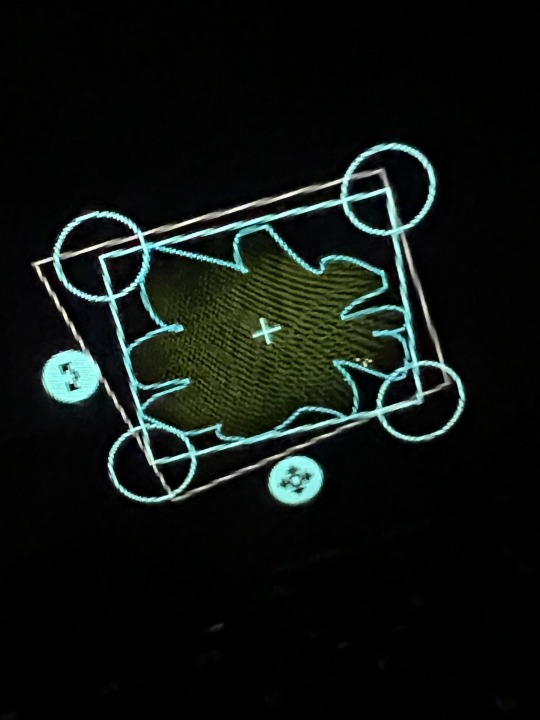
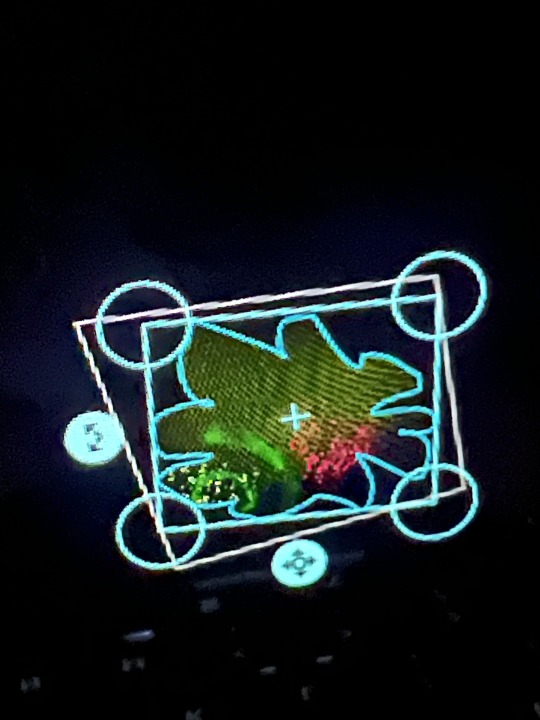
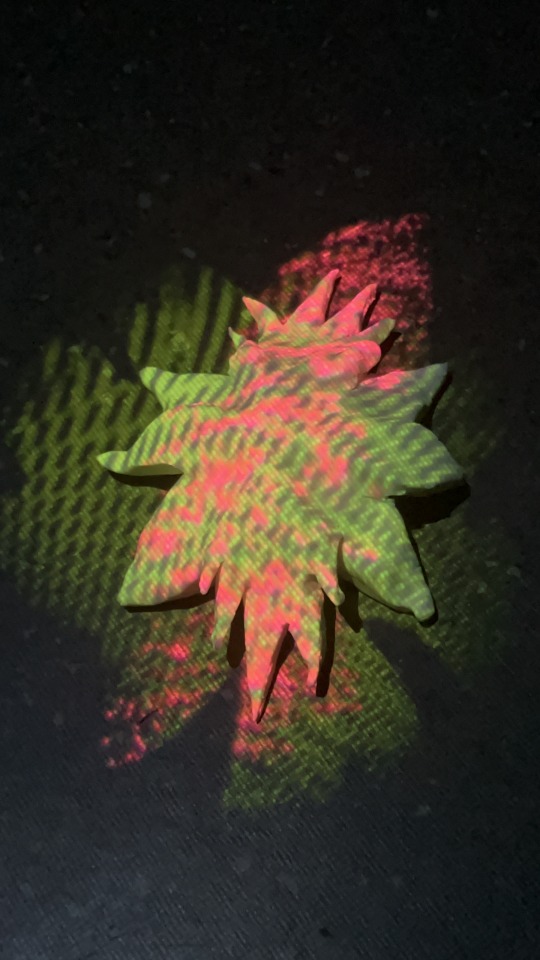
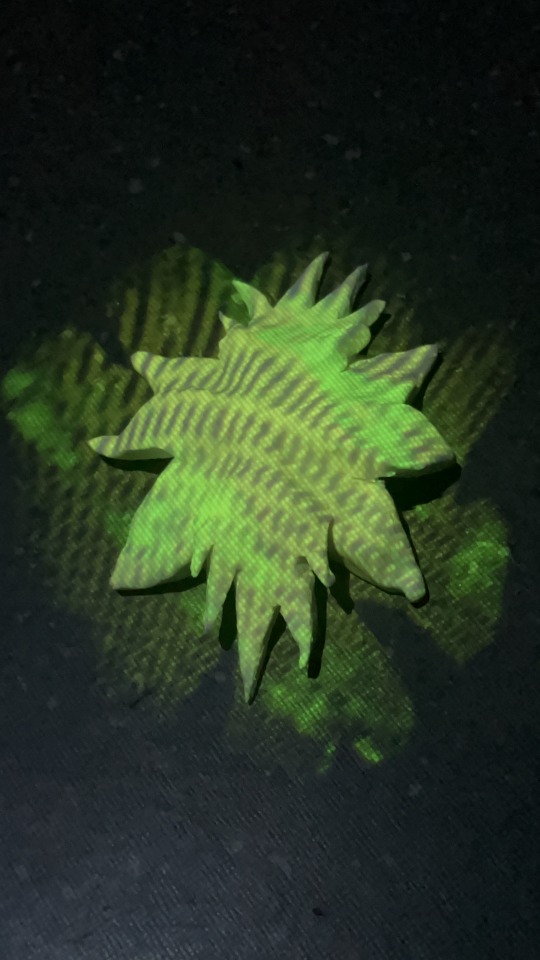
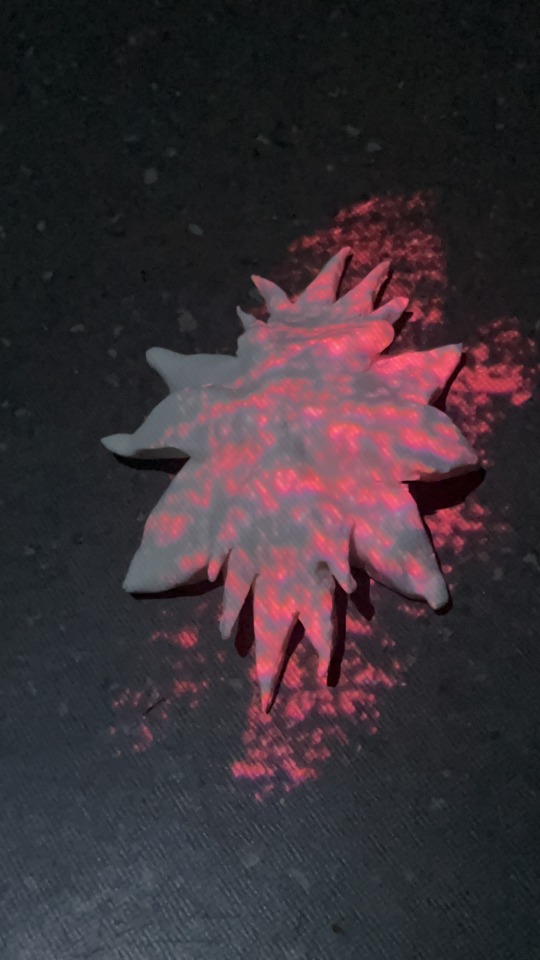
#sca projects#year 3 art studio project 2#sca usyd new contemporaries grad show#aa sca yr 3 sem 2 week 8
0 notes
Text
Projection Design: Improving Visual Narrating in Cutting edge Media
Projection design, too known as projection mapping, is an imaginative procedure that has revolutionized the way visual narrating is displayed in present day media. By anticipating pictures, recordings, and livelinesss onto different surfaces, creators can make immersive and energetic visual encounters that charm groups of onlookers. This article digs into the essentials of projection plan, its applications, and the imaginative conceivable outcomes it offers.
The Basics of Projection Design
Projection design includes the utilize of specialized program and equipment to outline visual substance onto surfaces, changing them into energetic shows. The key components of a projection design setup include:
1. Projectors: High-quality projectors are basic for making clear and shinning pictures. The choice of projector depends on variables such as determination, brightness, and toss distance.
2. Surface Mapping: The prepare of mapping includes adjusting the anticipated substance with the forms and highlights of the surface. This can be accomplished utilizing computer program that permits creators to alter the geometry and point of view of the images.
3. Substance Creation: Planning the visual substance is a basic perspective of projection plan. This can incorporate inactive pictures, recordings, movements, and intelligently components. The substance must be custom-made to fit the mapped surface accurately.
4. Computer program: Different program instruments are accessible for projection mapping, such as MadMapper, Resolume, and TouchDesigner. These programs permit architects to control the projection, control the substance, and synchronize it with other components like sound and lighting.
Applications of Projection Design
Projection plan is utilized over different businesses to upgrade visual encounters. A few common applications include:
1. Amusement: In theater, concerts, and live occasions, projection plan is utilized to make shocking backdrops and visual impacts that improve the execution. It permits for the change of organize sets and gives energetic visual storytelling.
2. Promoting: Businesses utilize projection mapping for promoting by anticipating special substance onto buildings and other structures. This procedure makes eye-catching and important promotions that stand out in urban environments.
3. Historical centers and Shows: Projection plan is utilized in exhibition halls and shows to make intelligently shows and immersive situations. It makes a difference in showing authentic occasions, logical concepts, and creative establishments in locks in ways.
4. Design: Designers and architects utilize projection mapping to visualize and show structural ventures. It permits clients to see practical representations of buildings and spaces some time recently they are constructed.
5. Retail: In retail, projection plan can improve the shopping encounter by making intelligently window shows and in-store visual marketing. It pulls in clients and energizes engagement with the brand.
Imaginative Possibilities
The inventive conceivable outcomes of projection plan are essentially boundless. Creators can try with distinctive strategies to accomplish different effects:
1. 3D Mapping: By anticipating substance onto three-dimensional objects, creators can make the figment of changing the object's shape and appearance. This method is frequently utilized in aesthetic establishments and performances.
2. Intuitively Projections: Joining intuitively components permits groups of onlookers to lock in with the projection in genuine time. This can be accomplished through movement sensors, touchscreens, or portable devices.
3. Expanded Reality (AR): Combining projection plan with AR innovation empowers the mixing of advanced substance with the physical world. This can be utilized in instructive settings, gaming, and immersive experiences.
4. Site-Specific Establishments: Projection mapping can be custom-made to fit particular areas and settings, making one of a kind visual encounters that reverberate with the environment and audience.
Conclusion
A projection plan is an effective device that improves visual narrating in present-day media. Its applications span different businesses, advertising imaginative arrangements for amusement, publicizing, instruction, and more. As innovation advances, the conceivable outcomes for the projection plan will extend, opening modern roads for specialists, architects, and storytellers to fascinate and lock in groups of onlookers. Whether utilized for making immersive situations or energetic visual impacts, projection plans remain at the bleeding edge of advancement in visual media.
#Broadway#Projection Design#Stage Design#Theater Technology#Visual Arts#Broadway Productions#Theatrical Innovation
0 notes
Text
Tips for Creating Audio Visual Content for Music Festivals with Software
In the electrifying world of music festivals, the experience transcends mere auditory pleasure – it's a multisensory journey that captivates audiences with a harmonious fusion of sound, light, and visuals. As the demand for immersive and unforgettable experiences continues to soar, event organizers and creative teams are turning to the power of audio visual design software to elevate their productions to new heights. However, to truly harness the potential of this technology, careful planning and consideration must be given to the AV room"– the nerve center where audio and visual elements converge to create magic. And we will also discuss how to do planning a new av room.
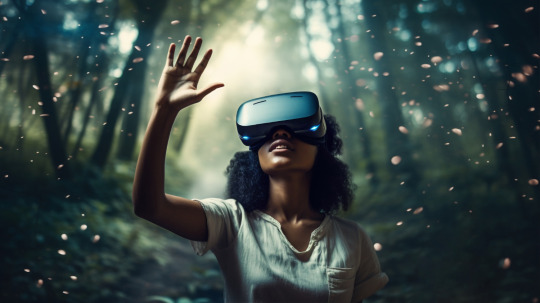
Planning a New AV Room: The Cornerstone of Immersive Music Festivals
An AV room is a dedicated space that serves as the central hub for audio and visual control, monitoring, and content management during a music festival. This specialized environment is meticulously designed and configured to support the seamless integration of various audio and visual components, ensuring that every element works in harmony to deliver a captivating and cohesive experience.
Understanding the Complexities of AV Integration for Music Festivals
Music festivals are inherently complex events, involving a multitude of stages, performers, and technical elements that must be carefully orchestrated. The integration of audio and visual components within this dynamic environment presents a unique set of challenges, such as managing multiple signal paths, ensuring synchronization, and adapting to ever-changing lighting and environmental conditions.
The Role of the AV Room
The AV room plays a pivotal role in addressing these complexities by providing a controlled and optimized environment for audio and visual management. By carefully designing the layout, acoustics, and environmental conditions of the AV room, event organizers and technical teams can ensure that their audio and visual content is monitored, controlled, and delivered with the highest possible fidelity and precision.
Audio Visual Design Software for Music Festivals
To create captivating and immersive audio visual experiences at music festivals, creative teams have access to a wide range of powerful design software tools that streamline the creation, editing, and integration processes.
Live Video Mixing and Projection Mapping Software
Live video mixing and projection mapping software are essential tools for creating dynamic and visually stunning displays at music festivals. Software like Resolume Arena, MadMapper, and Watchout offer advanced features for mixing and mapping video content onto various surfaces, enabling creative teams to transform stages and environments into ever-changing canvases of light and motion.
Resolume Arena
Resolume Arena is a powerful video mixing and projection mapping software that offers a wide range of features for creating stunning visual experiences. With its advanced mapping capabilities, real-time video effects, and support for various input sources, Resolume Arena is a versatile tool for music festival productions.
Audio Mixing and Sound Design Software
Sound is the lifeblood of music festivals, and audio mixing and sound design software play a crucial role in shaping the auditory experience. Tools like Ableton Live, Pro Tools, and Reaper offer advanced features for mixing live audio, incorporating sound effects, and creating immersive sonic landscapes that complement the visual elements of the production.
Ableton Live
Ableton Live is a widely used digital audio workstation (DAW) that offers a comprehensive set of tools for audio editing, sound design, and live performance. With its intuitive interface, powerful audio manipulation capabilities, and seamless integration with various hardware and software components, Ableton Live is a powerful choice for music festival productions.
Lighting Control and Visualization Software
Lighting is a crucial element in creating captivating audio visual experiences at music festivals, and lighting control and visualization software play a vital role in orchestrating these dynamic displays. Tools like grandMA, Vectorworks Spotlight, and Lightwright allow creative teams to design, program, and control intricate lighting setups, ensuring that every performance is perfectly illuminated and synchronized with the audio and visual elements.
grandMA
grandMA is a powerful lighting control and visualization software widely used in the entertainment industry. With its advanced programming capabilities, real-time visualization tools, and seamless integration with various lighting fixtures, grandMA empowers creative teams to create stunning lighting designs that elevate the overall audio visual experience at music festivals.
Best Practices for Creating Engaging Audio Visual Content for Music Festivals
While the integration of audio visual design software is essential for creating compelling music festival experiences, it's crucial to follow best practices to ensure optimal performance and audience engagement.
Prioritizing Synchronization and Timing
Music festivals are dynamic events that rely heavily on precise timing and synchronization between audio, visual, and lighting elements. Creative teams should prioritize the use of timecode and synchronization protocols to ensure that all components are perfectly aligned, delivering a cohesive and seamless audio visual experience.
Embracing Collaboration and Interdisciplinary Approaches
Creating captivating audio visual content for music festivals often involves collaboration between various disciplines, such as music production, visual arts, lighting design, and technical engineering. Embracing interdisciplinary approaches and fostering open communication between team members can lead to innovative and boundary-pushing productions that push the boundaries of creativity.
Adapting to Environmental Conditions
Music festivals often take place in outdoor or unconventional venues, where environmental factors such as weather, lighting conditions, and crowd dynamics can impact the audio visual experience. Creative teams should be prepared to adapt their content and technical setups to accommodate these variables, ensuring that the audio visual experience remains consistent and engaging throughout the event.
Prioritizing Safety and Compliance
Music festivals involve large crowds and complex technical setups, making safety and compliance with regulations a top priority. Creative teams should ensure that their audio visual designs and installations adhere to industry standards and local regulations, prioritizing the safety and well-being of performers, crew, and attendees.
Conclusion: Elevating Music Festivals with Audio Visual Design Software
In the exhilarating world of music festivals, audio visual design software has become an indispensable tool for creative teams, enabling them to craft immersive and captivating experiences that transport audiences to new realms of sight and sound. By leveraging the power of advanced audio, visual, and lighting technologies, and meticulously planning the AV room, event organizers and creative teams can weave together a tapestry of music, visuals, and dynamic elements that captivate and inspire. As technology continues to evolve, the possibilities for audio visual design in music festivals are boundless, offering a canvas for artists, technicians, and performers to push the boundaries of creativity and create transformative experiences that linger long after the final note fades.
0 notes
Text
post-vicki's show thoughts
so! vicki's show was great. it was a cool collection of related things, where the relationship was conveyed by the shapes and materials and colours. it was very very subconscious-turned-into-physical-form feeling, which is great!!!!!!!!!!!!!!!!!!!!!!!!
i remember being there and thinking i wanted the gift shop to feel like that too, but idk how directly it inspired the later thoughts i had. luckily i recorded my later thoughts in my receipt roll thing, so here they are:
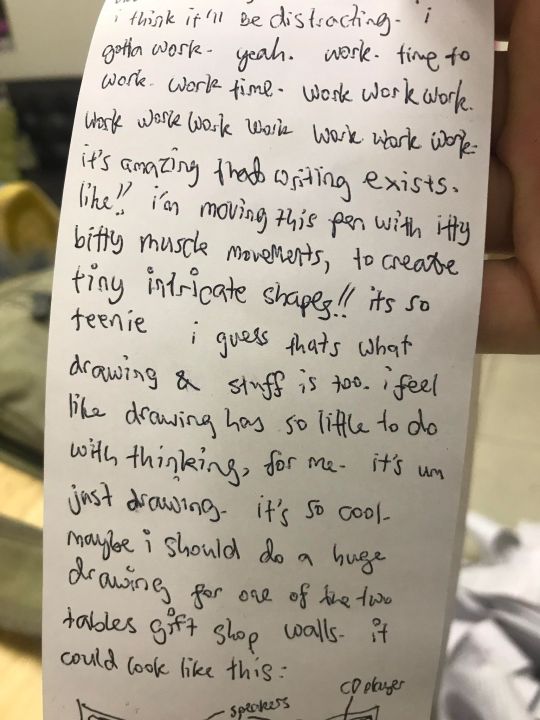
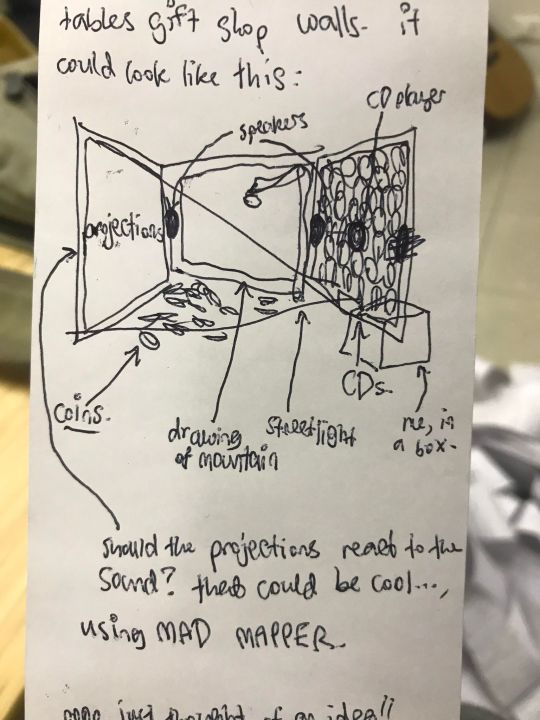
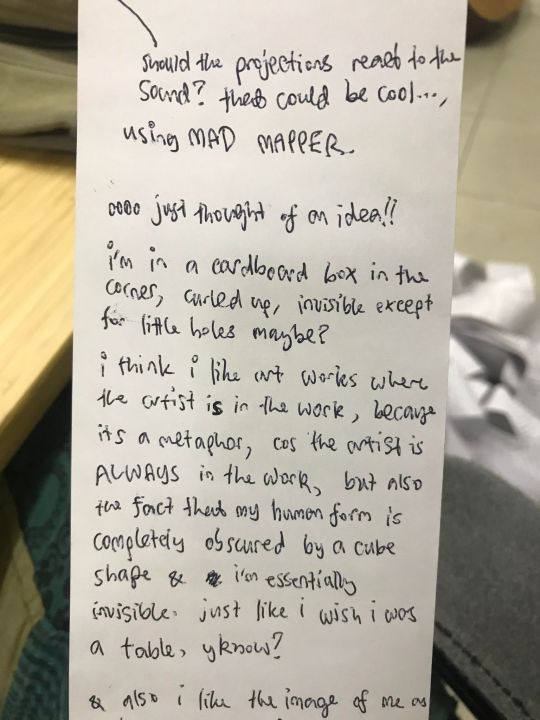
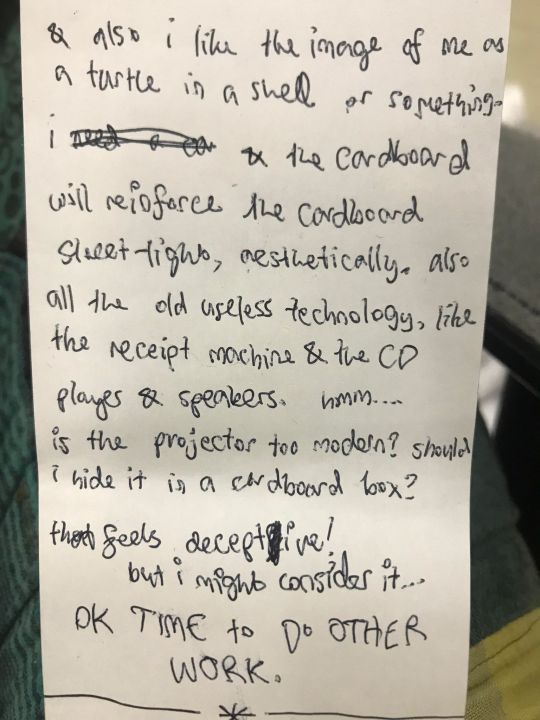
yeah! the new ideas are
to make one of the walls a gigantic drawing of a mountain, maybe on receipt roll paper.
to hide in a cardboard box in the corner of the room, (maybe a mountain-shaped box?, or the street light coming out of the top of the box?)
to create a gift shop catalogue, which can be sitting with "two tables go on a date", a little guide on where to go and what the smaller works are called, and stuff -- (lots of space for easter eggs and jokes and implications of meaning)
possibly mapping projections using madmapper onto objects attached to the projection-wall -- maybe projecting the moon onto a cd or something?
also i'm borderline certain i need the two tables to be on the stage of the hall, just so the theatrical nature of the performance is made clear
i'll do a quick drawing on bigger paper!!!
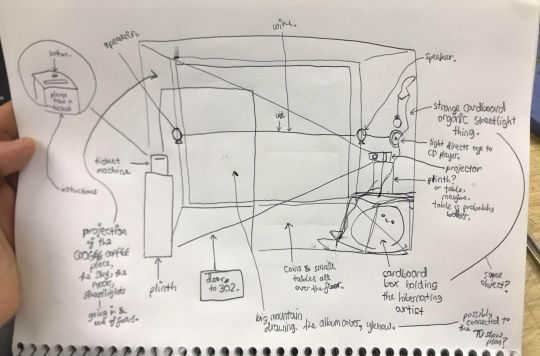
i'll explain more in a follow-up post, but i need to go to work!!!
0 notes